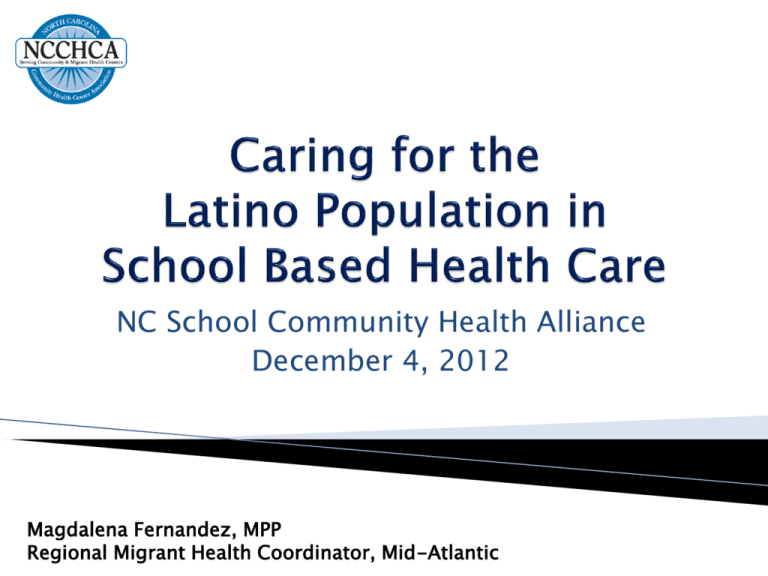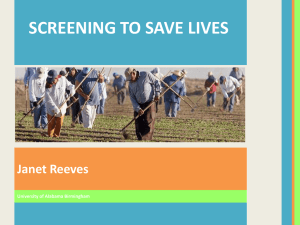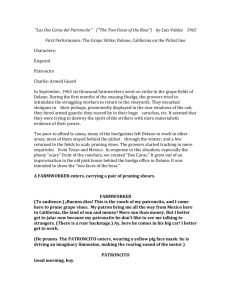Caring for the Latino Population in School Based
advertisement

NC School Community Health Alliance December 4, 2012 Magdalena Fernandez, MPP Regional Migrant Health Coordinator, Mid-Atlantic Latinos in SBHC Latinos in America What is culture? Health Care Interpretation Migrant Health 101 Resources Average percentage of Hispanics served at SBHC: Range of percentage of Hispanics Served at SBHC: 0%-55% 10% SBHCs with highest Hispanic Patient Population: ◦ First Health Montgomery County ◦ Southern HS Wellness Center ◦ Blue Ridge Site 1 ◦ Blue Ridge Site 2 ◦ Blue Ridge Site 3 ◦ Blue Ridge Site 4 ◦ Greene County (55%) (20%) (20%) (20%) (30%) (20%) (15%) In millions 50.5 35.3 22.4 14.6 1980 Source: Pew Hispanic Center. 1990 2000 2010 In percent Growth, 2000-2010 U.S. Total Source: 2010 U.S. Census. 43 South Carolina Alabama Tennessee Kentucky 148 145 134 122 Arkansas North Carolina Maryland Mississippi 114 111 106 106 South Dakota Delaware Georgia Virginia 103 96 96 92 Hispanic Population Growth, 2000-2010 90% growth or more 70% to 89% growth 40% to 70% growth Less than 40% growth Source: 2010 U.S. Census. 1,590 Counties With More Than 45% Growth Source: Pew Hispanic Center Population in millions 46.8 43 35 4.0 0 1950 22 15 1960 1970 1980 1990 2000 2010 2020 2030 2040 2050 2060 Population in millions 128 Middle "Baseline" Immigration 105 57 50.5 35 4.0 0 1950 22 15 1960 1970 1980 1990 2000 2010 2020 2030 2040 2050 2060 Which term to you use first to describe yourself? Country of origin 52% Latinos 16 to 25 3rd generation 20% 41% 32% Source: 2009 National Survey of Latinos 22% 3% 21% 15% American 24% 72% 1st generation 2nd generation Hispanic or Latino 33% 50% Mostly/Only Spanish Latinos 16 to 25 23% 2nd generation 3rd generation 9% Mostly/Only English 20% 48% 1st generation Equally 20% 2% 7% Source: 2009 National Survey of Latinos 56% 26% 70% 91% 26% Percent of Latino Youths using Spanglish at all when talking to friends or family Most of the time Some of the time Mostly/Only English Latinos 16 to 25 23% 47% 70% 1st generation 22% 47% 69% 2nd generation 3rd generation 26% 20% Source: 2009 National Survey of Latinos 53% 37% 78% 57% To be culturally competent doesn’t mean you are an authority in the values and beliefs of every culture. What it means is that you hold a deep respect for cultural differences and are eager to learn, and willing to accept, that there are many ways of viewing the world. --Okokon O. Udo ◦ ◦ ◦ ◦ ◦ ◦ ◦ ◦ ◦ Food Dress Traditions Gender Music Language Art Religion Values Surface culture History Identity Collective memory Relation to environment Concept of time Space The glasses through which we see life Deep culture Space Volume Tactile Eye contact Timing Direct/ indirect Silence Saying “no” Linear/ circular Small talk/ business Appropriate topics Smiling Gestures Gender roles in the US Gender roles over time Dress Occupation Work roles Family roles Children Spouse Physical violence Power dynamics The Maya of Morganton What is food???? Who prepares it? With whom do you eat? Where do you eat How is it eaten? When is it eaten? Race as a cultural construct Race vs. ethnicity Race and class in Brazil ◦ 500 different race-color terms •Many do not identify as Hispanic •Over 20 recognized Mayan languages in Guatemala •Mam, K’iche, Kanjobal Language Navigating the US health System Fear Traditional healing Interpretation vs. Translation Spoken and Written Role of Interpreter How to work with interpreters Section 330g of the Public Health Service Act Migratory Agricultural Worker ◦ Principal employment is in agriculture ◦ Has been so employed within the last 24 months ◦ Establishes a temporary home for the purpose of such employment. Seasonal Agricultural Worker ◦ Principal employment is in agriculture on a seasonal basis ◦ Does not migrate Farming in all federal government branches include: A) Cultivation and tilling of the soil B) Production, cultivation, growing, & harvesting of any commodity grown on, in or as adjunct to the land C) Preparation & processing for market and delivery to storage or market, to carriers for transportation to market (performed by a farmer or on a farm) 3 11 9 1 4 8 5 7 6 10 2 Farmworker Demographics1 1. Findings from the National Agricultural Workers Survey (NAWS) 2007 - 2009. Demographic and Employment Profile of United States Farm Workers. 2. Kandel W. Profile of Hired Farmworkers, A 2008 Update. Economic Research Service, US Department of Agriculture; Washington, DC; 2008. Economic Research Report No. 60. * Note: Kandel uses a combination of NAWS and others data. 3. Martin P. Immigration reform: implications for agriculture University of California, Giannini Foundation. Agricultural and Resource Economics Update. 2006;9(4). Farmworker Demographics1 Farmworker Demographics1 4. Per Capita Personal Income in 2008. U.S. Dept. of Commerce, Bureau of Economic Analysis. Released March 2012. http://bber.unm.edu/econ/us-pci.htm 5. Federal Poverty Level in 2008 Household size 1. Health Assistance Partnership. http://www.hapnetwork.org/medicaid/fpl-2008.html Increase in the number of H-2A workers More males traveling alone Fewer families traveling together More established in rural communities as seasonal workers Less trans-border crossing Engaged in other industries during the off season (construction, meat processing, dairy and others) Photo © Ed Zuroweste Source: Passel, 200 Agriculture is one of the most hazardous occupations in the United States1 In 2010, 323 farmworkers died of work-related injuries2 About 20% of farmworkers and their families went to a C/MHC in 20113 1. CDC, NIOSH, Workplace and Safety Health Topics: Agricultural Safety, http://www.cdc.gov/niosh/topics/aginjury/ 2. Bureau of Labor Statistics, Census of Fatal Occupational Injuries, http://www.bls.gov/iif/oshwc/cfoi/cftb0252.pdf 3. HRSA UDS Data 2011 Heat stress Equipment & automobile accidents Lacerations from sharp equipment and hand tools Falls from ladders Eye injuries Musculoskeletal injuries Insect/rodent/snake bites Photo by Farmworker Justice Pesticide exposure in the fields and at home Photo © Earl Dotter Gastrointestinal diseases Intestinal parasites Urinary tract infections Conjunctivitis Lead poisoning Photos by Farmworker Justice Diabetes Hypertension Cancer HIV/AIDS Tuberculosis Obesity Asthma Photo by Farmworker Justice Anxiety Stress Depression Substance abuse Domestic violence Contributing factors: Separation from families Isolation Discrimination Fear due to immigration status According to a 2008 NC study, 40% of farmworker participants reached the threshold for potential clinically-significant depression • Cultural issues such as language, literacy, medical knowledge, health care practices and beliefs, and dietary practices • Social support absent because of social exclusion or isolation • Food insecurity and/or lack of access to healthy foods Photo © Earl Dotter • Poverty, with unreliable transportation, lack of insurance, inability to buy services and supplies, and substandard housing • Limited job security increases the possibility that workers will remain in a dangerous or questionable job to remain employed • Unavailability of sick leave • Fear of employer retaliation Photo © Erin Bascom • Constant mobility causing discontinuity of care • Immigration status of patient and/or family members • Racism that motivates policies or actions that frighten members of particular racial/ethnic groups. • Confusion about US health systems Photo © Earl Dotter • Bilingual staff • Post clinic schedules in multiple languages • Walk-in appointments • Mobile health units • Patient education materials in English and other languages geared towards lower literacy levels • Outreach workers/promotores de salud • Partner with community-based organizations and local immigrant-serving institutions • 41 Provide transportation services Photo by Migrant Health Promotion 330 (e) Community Health Center 330 (g) Migrant Health Center Voucher Programs 330 (h) Health Care for the Homeless 330 (i) Public Housing Health center and voucher programs include: Primary care services Preventive services Emergency services Pharmacy services Outreach and enabling services Service Delivery Challenges Culture and Language • Provision of multi-lingual services (i.e. reception, health education, patient education, prescription instructions, health center promotional information, medical visit, etc.) • Meeting Culturally and Linguistically Appropriate Services (CLAS) standards • Recruitment and retention of qualified bilingual and bicultural staff • Relevant training and continuing education of staff • Fear/lack of trust Demand • Exceeds capacity • Staff capacity • Seasonal fluctuations Operations • Integration of walk-in patients into appointment system • Provision of transportation in rural areas Costs • MHCs must remain competitive despite the escalating costs in the health care industry • Lack of insurance coverage of the population • Many MSFWs will not be eligible for Medicaid or enrollment in the state health insurance exchanges enacted under the ACA due to immigration status • Outreach and enabling services are not reimbursable Photo by Tony Loreti for Migrant Health Promotion Cultural adaptations ◦ Culturally sensitive education ◦ Appropriate language and literacy levels ◦ Address cultural health beliefs & values Mobility adaptations ◦ Portable medical records & Bridge case management Appropriate service delivery models ◦ ◦ ◦ ◦ Case Management Lay health promoters (Promotoras) Outreach & enabling services Coordination with schools and worksites Continuity of care is the most challenging issue in the provision of quality of care for FWs because: • FWs may seek care only when it is necessary • Once treatment begins, FWs may move • If FWs seek care when they arrive in the next • • community, they may not remember the name or dose of the medication they are taking FWs may take records with them, but often lose them Communication between MHCs and other providers is difficult 1. What aspects of the health center team worked well in serving Pablo? 2. What did not work well for the team regarding Pablo’s case? 3. What could the team do differently in the future to be more effective. Farmworker Health Network Farmworker Justice www.farmworkerjustice.org Health Outreach Partners www.outreach-partners.org Migrant Clinicians Network www.migrantclinician.org Migrant Health Promotion www.migranthealth.org National Association of Community Health Centers www.nachc.com National Center for Farmworker Health www.ncfh.org Regional Migrant Health Coordinators fernandezm@ncchca.org Regional Migrant Health Coordinators Coverage Areas NCFH 2012 Recognize areas of need in region Connect clinics to resources Provide support to new sites Monitor federal legislature Anticipate and facilitate migratory transitions from state to state







